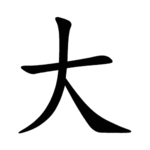| 大 | ||
|---|---|---|
| ||
| 大 (U+5927) "big, very" | ||
| Pronunciations | ||
| Pinyin: | dà | |
| Bopomofo: | ㄉㄚˋ | |
| Gwoyeu Romatzyh: | dah | |
| Wade–Giles: | ta4 | |
| Cantonese Yale: | daaih | |
| Jyutping: | daai6 | |
| Pe̍h-ōe-jī: | tāi | |
| Japanese Kana: | ダイ dai / タイ tai (on'yomi) おお ō / おお-きい ō-kii (kun'yomi) | |
| Sino-Korean: | 대 dae | |
| Hán-Việt: | Đại | |
| Names | ||
| Chinese name(s): | (Top) 大字頭/大字头 dàzìtóu | |
| Japanese name(s): | 大/だい dai (Top) 大頭/だいがしら daigashira (Top) 大冠/だいかんむり daikanmuri | |
| Hangul: | 클 keul | |
| Stroke order animation | ||
 | ||
Radical 37 or radical big (大部) meaning "big" or "very" is one of the 31 Kangxi radicals (214 radicals total) composed of three strokes.
In the Kangxi Dictionary, there are 132 characters (out of 49,030) to be found under this radical.
大 is also the 33rd indexing component in the Table of Indexing Chinese Character Components predominantly adopted by Simplified Chinese dictionaries published in mainland China.
Evolution
[edit]-
Oracle bone script character
-
Bronze script character
-
Large seal script character
-
Small seal script character
Derived characters
[edit]| Strokes | Characters |
|---|---|
| +0 | 大 夨 |
| +1 | 天 太 夫 夬 夭 |
| +2 | 央 夯 夰 失 夲 夳 头SC (=頭 -> 頁) |
| +3 | 夵 夶 (=比 -> 比) 夷 夸 (also SC form of 誇 -> 言) 夹SC (=夾) 夺SC (=奪) 夻 夼 |
| +4 | 夽 夾 夿 奀 奁SC (=奩) 奂SC (=奐) |
| +5 | 奃 奄 奅 奆 奇 奈 奉 奋SC (=奮) 奌 (=點 -> 黑) 奍 奔 |
| +6 | 奎 奏 奐 契 奒 奓 奕 奖SC (=獎 -> 犬) |
| +7 | 奊 套 奘 奙 奚 |
| +8 | 奛 奜 奝 奞 奟 |
| +9 | 奠 奡 奢 奣 奤 奥SC/JP (=奧) |
| +10 | 奦 奧 奨JP (=獎 -> 犬) |
| +11 | 奩 奪 奫 奬 (=獎 -> 犬) |
| +12 | 奭 |
| +13 | 奮 奯 |
| +15 | 奰 |
| +19 | 奱 |
| +21 | 奲 |
Sinogram
[edit]The radical is also used as an independent Chinese character. It is one of the Kyōiku kanji or Kanji taught in elementary school in Japan.[1] It is a first grade kanji.[1]
References
[edit]- ^ a b "The Kyoiku Kanji (教育漢字) - Kanshudo". www.kanshudo.com. Archived from the original on March 24, 2022. Retrieved 2023-05-06.
Further reading
[edit]- Fazzioli, Edoardo (1987). Chinese calligraphy : from pictograph to ideogram : the history of 214 essential Chinese/Japanese characters. calligraphy by Rebecca Hon Ko. New York: Abbeville Press. ISBN 0-89659-774-1.
- Lunde, Ken (Jan 5, 2009). "Appendix J: Japanese Character Sets" (PDF). CJKV Information Processing: Chinese, Japanese, Korean & Vietnamese Computing (Second ed.). Sebastopol, Calif.: O'Reilly Media. ISBN 978-0-596-51447-1.




Well, that’s interesting to know that Psilotum nudum are known as whisk ferns. Psilotum nudum is the commoner species of the two. While the P. flaccidum is a rare species and is found in the tropical islands. Both the species are usually epiphytic in habit and grow upon tree ferns. These species may also be terrestrial and grow in humus or in the crevices of the rocks.
View the detailed Guide of Psilotum nudum: Detailed Study Of Psilotum Nudum (Whisk Fern), Classification, Anatomy, Reproduction